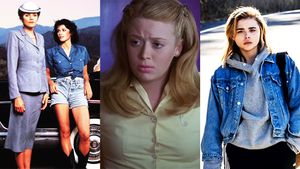The title of the
book begins on the back cover with the bold red letters
O L I. On the spine is another letter: V.
The front cover continues with I E R, under a photo
of a brooding, young Laurence Olivier. The
ostentatious look of a new, authorized biography of a
man considered to be one the greatest actors of the 20th
century seems fitting. In theater, films, and
television, Olivier commanded the stage and screen in
everything from Hamlet to The Prince and the
Showgirl with Marilyn Monroe.
Olivier is the result of four years of
scholarship by Terry Coleman, an English journalist,
novelist, and historian. He had two advantages over
other biographers of the actor: He interviewed Olivier
many times as correspondent for the Guardian of
London and had access to Olivier's collection of
letters and other memorabilia. "Olivier in his last
years kept all his papers in great big stage hampers in a
barn at his country place in Sussex," Coleman said
from his London home. "He was a bit dismissive about
them, and at one point he said, 'Get the gardener to
burn them."'
The gardener
didn't burn them, but after Olivier's death the papers were
forgotten and subject to the damp English winters. After
five years the family realized the value of the
collection, which includes business letters, love
letters, contracts, cast lists, and other items. They were
entrusted to the British Library. The estate's executors
chose Coleman to write the official Olivier biography.
They were impressed by The Nelson Touch, Coleman's
biography of British naval hero Admiral Horatio
Nelson. Olivier had portrayed Nelson in the 1940
made-in-Hollywood That Hamilton Woman, with his
future wife, Vivien Leigh, in the title role.
The romance of
Olivier and Leigh was widely publicized, especially since
both were married to others. They obtained divorces and
married in 1940. The marriage lasted 20 years. "Vivien
was quite mad," Coleman cited as the reason for their
1960 breakup. "It's a sad story. At the time, nobody
ever realized that Vivien Leigh was quite as mad as she was.
She died in 1967, and it came out in about 1980 that she had
in her last years been a manic-depressive. But what
nobody knew...was that she was mad as early as when
she was filming Gone With the Wind. She was
quite dreadful to work with because she wouldn't turn
up, and she was terribly nervous on the set. During the
filming she actually took an overdose."
Olivia de
Havilland, the sole surviving star of Gone with the
Wind, disputes what Coleman says about Leigh.
"Vivien was impeccably professional, impeccably
disciplined on Gone With the Wind," de
Havilland said from her home in Paris. "She had two great
concerns: doing her best work in an extremely
difficult role and being separated from Larry, who was
in New York playing No Time for Comedy with
Katharine Cornell. She worked until midnight on
Saturday so she could join Larry."
Plowing through
the mass of correspondence, the author discovered that
Olivier was a great letter writer. Starting in his late 20s,
he kept the letters written to him and made carbon
copies of his replies. When he was directing Leigh in
the London debut of A Streetcar Named Desire,
Olivier realized the play was too American for British
audiences. He sent a 32-page handwritten letter to Tennessee
Williams suggesting changes. The playwright was so
astonished that he authorized the revisions.
Coleman devotes a
seven-page author's note at the end of the Olivier
text to the matter of "The Androgynous Actor." He
considered various reports that Olivier was bisexual.
One biography printed after his death alleged that Olivier
"was deeply involved in a homosexual affair with Danny
Kaye." "This sort of thing is very difficult to
check," Coleman said in the interview. "I did check it
and talked to a number of people. In this mountain of
material in the archives I could not find a hint of an
affair with Danny Kaye. His third wife [Joan Plowright] had
no inkling of it, and I believe her. What I did find
was evidence of a homosexual affair in 1937 with an
actor called Henry Ainley. He was a big name of the
1910s and 1920s. I'm not sure this is a terribly important
thing. It's there and it's a fact and therefore I
report it."
The author
declared he found no other evidence about Olivier's
bisexuality. In his 1982 autobiography, Olivier hinted at a
homosexual "dalliance," Coleman writes, prompting
readers to assume that the "one male" had been Noel
Coward. The author considers Ainley more likely.
During the last
22 years of Olivier's life, Coleman said, he was ill
"with an awful succession of diseases." (Olivier died July
11, 1989, at 82.) "He insisted on acting as long as he
could," said the biographer. "When he could no longer
direct, he acted in films, mostly in cameo parts at $1
million apiece. When he couldn't stand the trip to
Hollywood, he made two terrific television films in
England-- Brideshead Revisited and King
Lear." (Bob Thomas, AP)


















































































